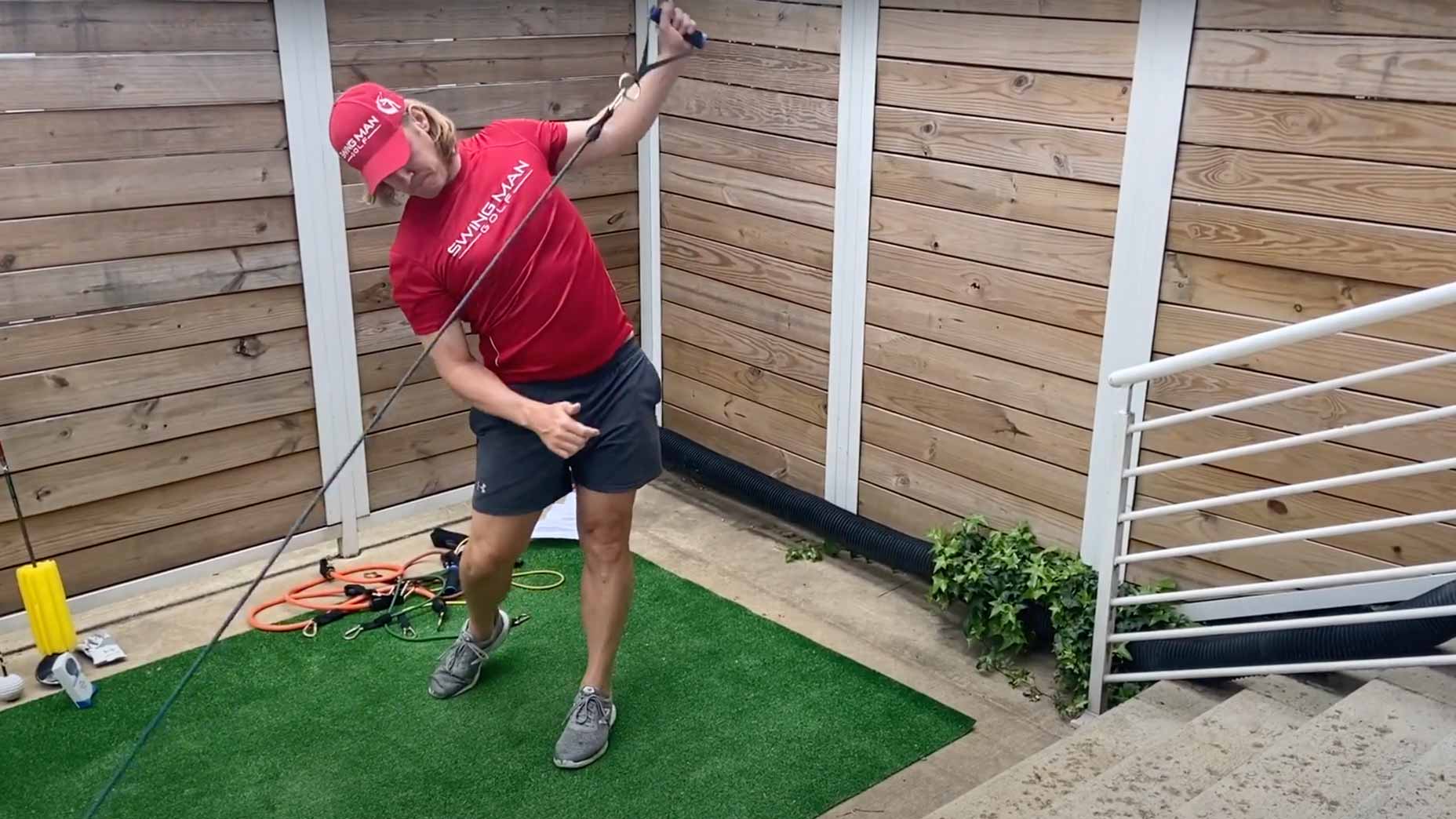Golf is a game of precision, strategy, and finesse, but one of the most crucial aspects of improving your performance is enhancing your swing speed. Faster swing speed not only means hitting the ball further but also improving your overall game.
Key Takeaways
- Increasing swing speed can add 2-3 yards to your shot for every 1 mph increase.
- Strength, flexibility, and coordination are key components of swing speed.
- Dynamic stretching and balance drills are essential for effective warm-ups.
- Regular strength training and plyometric exercises can significantly boost swing speed.
- A personalized training plan with realistic goals is crucial for continual improvement.
The Importance of Golf Swing Speed
Golf swing speed isn't just about hitting the ball farther; it plays a pivotal role in your overall game performance. A faster swing translates to greater distance, allowing you to cover more ground with fewer strokes.
Impact on Distance and Accuracy
Most importantly, a higher swing speed means increased ball distance. For every 1 mph increase in swing speed, you can expect to add 2-3 yards to your shot. This can be the difference between reaching the green in regulation or falling short.
Besides that, faster swing speeds can improve your smash factor, leading to better energy transfer from the club to the ball, which enhances both distance and accuracy.
Mental and Physical Benefits
Beyond the physical advantages, knowing you have the power to drive the ball further boosts your confidence. This mental edge can significantly affect your performance under pressure. Physically, training to increase swing speed improves overall fitness, which can lead to better endurance on the course.
Key Components of Swing Speed
To boost your swing speed, it's essential to focus on three main components: strength, flexibility, and coordination. These elements work together to create a powerful and efficient swing. For more insights, check out this golf speed training guide.
Strength and Muscle Development
Strength forms the foundation of a powerful swing. Developing muscles in key areas like the legs, core, and arms can significantly enhance your swing speed. Exercises such as deadlifts, squats, and bench presses are effective for building the necessary strength.
Flexibility and Mobility
Flexibility is equally important. A flexible body can achieve a greater range of motion, which is crucial for maximizing swing speed. Stretching exercises focusing on the shoulders, hips, and back can improve your flexibility and help prevent injuries.
For instance, incorporating yoga or Pilates into your routine can enhance your mobility and ensure you maintain a full, fluid swing.
Coordination and Timing
Coordination and timing are the glue that binds strength and flexibility. They ensure that all parts of your body work in harmony to deliver a fast, accurate swing. Drills that focus on timing, such as practicing with a metronome or using swing aids, can help refine these skills.
Warm-Up Techniques for Golfers
Before hitting the course or diving into intense workouts, warming up is essential. Proper warm-ups prepare your body for the physical demands of swinging at high speeds and help prevent injuries.
Dynamic Stretching
Dynamic stretching involves active movements that mimic the actions you'll perform on the course. These stretches increase blood flow, improve flexibility, and prepare your muscles for the explosive movements of a golf swing.
Examples of dynamic stretches include arm circles, leg swings, and torso twists. These exercises should be performed for about 5-10 minutes before starting your game or training session.
Balance Drills
Balance is a critical component of an effective swing. Simple drills, such as standing on one leg while performing a swing motion or using a balance board, can improve your stability and control during your swing. For those looking to refine their technique further, exploring expert tips to increase swing speed can be beneficial.
Activation Exercises
Activation exercises target specific muscles that are crucial for your swing. These exercises wake up the muscles, ensuring they are ready to perform at their best. Exercises like glute bridges, plank variations, and shoulder rotations are excellent for activation.
By incorporating these warm-up techniques into your routine, you'll be better prepared for both practice and play, setting the stage for improved swing speed and overall performance.
Targeted Workouts for Swing Speed
To effectively increase your golf swing speed, it's essential to incorporate targeted workouts into your training routine. These workouts focus on building the strength, power, and stability needed for a faster and more efficient swing.
Strength Training Exercises
Strength training is crucial for developing the muscles that contribute to swing speed. Focus on compound exercises that engage multiple muscle groups. Key exercises include:
- Deadlifts: These build explosive lower body strength, which is vital for a powerful swing.
- Squats: Squats enhance leg power and stability, essential for maintaining balance throughout your swing.
- Bench Press: This exercise strengthens the chest and arms, contributing to the power behind your swing.
Plyometric Drills
Plyometrics are exercises that involve explosive movements to increase power and speed. Incorporating these drills can significantly enhance your swing speed by improving muscle coordination and timing.
Examples of effective plyometric drills include:
- Box Jumps: These improve leg power and explosiveness, crucial for generating speed in your swing.
- Medicine Ball Slams: This exercise enhances core strength and upper body power, contributing to faster swing speeds.
- Jump Squats: Jump squats build explosive leg strength, which is essential for driving the ball further.
Core Stability Workouts
Your core is the powerhouse of your golf swing. A strong core provides the stability and rotational power needed for an efficient swing. Core stability workouts should be a regular part of your training regimen. For more tips, check out this guide on golf speed training.
Effective core exercises include:
- Planks: Planks build overall core strength and endurance, supporting a stable swing.
- Russian Twists: These exercises enhance rotational power, crucial for a powerful swing.
- Medicine Ball Rotations: This drill improves dynamic core strength and mimics the rotational movements of a golf swing.

"How to add 15 mph clubhead speed in 30 ..." from golf.com and used with no modifications.
Creating a Personalized Training Plan
To maximize your swing speed improvements, it's important to create a personalized training plan tailored to your specific needs and goals. A well-structured plan will help you stay focused and track your progress effectively.
Setting Realistic Goals
Begin by setting achievable goals for your swing speed. Consider your current abilities and set incremental targets that challenge you but are still within reach. For instance, aim to increase your swing speed by 5% over the next three months.
Tracking Progress
Regularly tracking your progress is essential for staying motivated and identifying areas for improvement. Use tools like swing speed monitors or video analysis to measure your progress and make necessary adjustments to your training plan.
Keep a training journal to record your workouts, swing speed measurements, and any changes in your performance. This will help you identify patterns and make informed decisions about your training.
Adjustments and Variations
Your training plan should be flexible and adaptable. As you progress, you'll need to make adjustments to your workouts and goals to continue improving. Vary your exercises and incorporate new drills to prevent plateaus and keep your training engaging.
For example, if you've been focusing primarily on strength training, consider adding more plyometric drills or flexibility exercises to your routine. This balanced approach will ensure comprehensive development and sustained improvements in swing speed.
Common Mistakes to Avoid
When training to increase swing speed, it's important to avoid common pitfalls that can hinder your progress or lead to injury.
Neglecting Proper Warm-Ups
Skipping warm-ups is a common mistake that can lead to injuries and decreased performance. Always start your training sessions with dynamic stretching and activation exercises to prepare your body for the demands of high-speed swings.
Remember, a proper warm-up not only prevents injuries but also ensures you perform at your best during workouts and on the course.
Overemphasizing Arms
Another common mistake is focusing too much on arm strength. While strong arms are important, swing speed comes from the whole body working together. Emphasize exercises that build strength and coordination in your legs, core, and upper body.
Ensure your training routine includes a balance of exercises that target all the key muscle groups involved in your swing. This holistic approach will lead to more significant improvements in swing speed and overall performance.
Ignoring Recovery Times
One of the most overlooked aspects of swing speed training is recovery. Many golfers make the mistake of training too hard without allowing their bodies the necessary time to rest and recuperate. Recovery is where your muscles repair and grow stronger, enabling you to achieve those desired speed gains.
Overtraining can lead to fatigue, decreased performance, and even injuries. Therefore, it's crucial to incorporate rest days into your training regimen. Listen to your body and give yourself time to recover, especially after intense workouts.
Continual Improvement and Next Steps
Improving your swing speed is an ongoing journey. As you make progress, it's important to continually assess your performance and make adjustments to your training plan. This ensures that you keep moving towards your goals and avoid stagnation.
Reviewing and Analyzing Performance
Regularly review your swing speed metrics and analyze your performance. Use tools like video analysis or swing speed monitors to track your progress and identify areas that need improvement. This data-driven approach allows you to make informed decisions about your training and focus on the aspects that will yield the greatest results.
Additionally, seek feedback from coaches or experienced golfers. They can provide valuable insights and guidance to help you refine your technique and maximize your swing speed.
Remember, continual improvement is about being proactive and making necessary changes to your training routine. Stay committed to your goals and be willing to adapt as you progress. For more insights on how to adapt, check out this guide on adapting to green speed variations.
Incorporating Regular Assessments
Regular assessments are key to tracking your progress and ensuring that you're on the right path. Schedule periodic evaluations to measure your swing speed, strength, flexibility, and overall performance.
- Test your swing speed using a launch monitor or swing speed radar.
- Assess your strength and flexibility through specific exercises and mobility tests.
- Evaluate your overall performance on the course to see how your improvements translate into real-game scenarios.
These assessments provide valuable feedback and allow you to make data-driven decisions about your training plan. Use them to identify strengths and weaknesses, and adjust your workouts accordingly.
By incorporating regular assessments, you'll have a clear understanding of your progress and be better equipped to achieve your swing speed goals.
Building Mental Resilience
Improving swing speed requires not only physical effort but also mental resilience. Golf is a mentally challenging sport, and developing a strong mindset is crucial for success.
Practice mental exercises such as visualization, positive self-talk, and goal setting. These techniques can help you stay focused, confident, and motivated throughout your training journey.
Additionally, embrace setbacks as learning opportunities. Every challenge you face is a chance to grow and improve. By cultivating mental resilience, you'll be better equipped to handle the ups and downs of the game and continue striving for excellence. For more insights on improving your game, explore how putters' weight distribution can enhance your performance.
Frequently Asked Questions (FAQ)
Here are some common questions about swing speed training and their answers to help you gain a better understanding of the process.
How does swing speed correlate with ball distance?
Swing speed directly affects how far the ball travels. For every 1 mph increase in swing speed, you can expect to add approximately 2-3 yards to your shot. This is because a faster swing speed results in greater energy transfer from the club to the ball, propelling it further down the fairway.
What are simple exercises to start with?
Begin with basic exercises that focus on building strength and flexibility. Bodyweight exercises like push-ups, squats, and planks are excellent starting points. Additionally, incorporate dynamic stretches such as arm circles and leg swings to improve flexibility and prepare your body for more intense workouts.
Can young golfers benefit from speed training?
Yes, young golfers can benefit from speed training, but it's important to tailor the exercises to their age and physical development. Focus on building a strong foundation of coordination, balance, and flexibility. Encourage fun, age-appropriate activities that promote overall athleticism and gradually introduce more structured training as they grow older.
How often should I train to see improvement?
Consistency is key. Aim for 2-3 dedicated swing speed training sessions per week, allowing for adequate rest and recovery in between. This frequency strikes a balance between challenging your body and giving it time to adapt and improve. Remember, quality over quantity is essential, so focus on executing exercises with proper form and intensity.
What equipment aids in swing speed training?
Several pieces of equipment can aid in swing speed training. Consider using:
- Weighted Clubs: These help build strength and improve swing mechanics.
- Resistance Bands: Resistance bands add resistance to your swings, enhancing power and speed.
- Speed Sticks: These training aids focus on increasing swing speed through overspeed training techniques.
Incorporating these tools into your training routine can provide additional challenges and accelerate your progress.
In conclusion, improving your golf swing speed requires dedication, a well-rounded training plan, and a commitment to continual improvement. By focusing on strength, flexibility, coordination, and mental resilience, you'll be well on your way to achieving your swing speed goals and elevating your game to new heights.
Improving your golf swing speed is crucial for enhancing your game. By incorporating specific exercises and techniques, you can increase your swing speed and gain more distance on the course.

